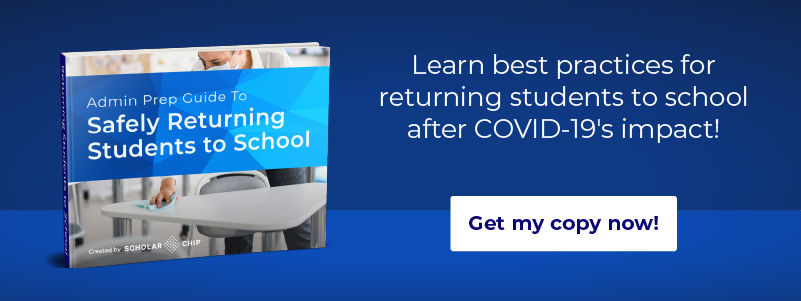In March 2020, more than 124 countries closed their education systems due to the COVID-19 pandemic. Since then, some have reopened, with modifications that can give American educators glimpses into what the 2020-2021 school year might be like. Even when more schools reopen, they likely will not look the same as they did before. For instance, the American Academy of Pediatrics suggests that schools may need to consider phased reopening, where only a certain number of students are on campus or in classrooms at certain times.
With so much uncertainty, it is important to remain flexible and consider novel ways to measure students’ educational progress and interactions with teachers. Let’s go over three ways to use ScholarChip’s already-existing tools for tracking student attendance, monitoring teacher/student interactions, and collecting data.
Focusing on Your Mission First
While the 2020-2021 school year will undoubtedly look different, your mission and goals for your institution will be the same. The Center for Global Development Karen Mundy and Susannah Hares states, “You have principles, goals, and targets for your education system. These have not changed, even if they need to be modified.”
So, your objective will be to protect your campus while ensuring that students meet the same educational goalposts you’ve always set for them. The ways that students meet said goals may look a bit different, but the goals themselves will remain the same.
Tracking Student Attendance
Like many countries, the United States may decide that when schools reopen, students should attend class in staggered periods. That means some students may attend classes in the morning, while others may attend them in the afternoon. We may also continue seeing a mixture of online and in-person learning.
While these modifications may be necessary—and perhaps even revolutionary—they will also require significant changes to your attendance tracking systems. With staggered class times, limited classroom numbers, and virtual options, it may seem impossible to track when and where students are on campus.
ScholarChip’s One Card and Secure Door Access platforms can eliminate this ambiguity. When schools reopen and students return to campus, each one can receive an identification card that has a chip embedded with their unique ID number. Students can then tap these ID cards onto card readers when they enter classrooms.
These solutions will help administrators handle increasingly complex face-to-face class attendance, and it will ensure that only a set number of students are in classrooms at a given time.
Collecting Data for Student Success
This kind of attendance data is not only practical, but it can also be used to decide if the COVID-19 modifications you’ve made on your campus are effective. It can also be used to simplify reporting to state and federal agencies. ScholarChip’s Admin Portals give you access to real-time information, like attendance data, and help you compile reports that education offices may require.
One of the recommendations made by many education offices is that administrators must be flexible in adapting to these new recommendations. That means you may need to alter the choices you make at the start of the semester based on what the data tells you.
For example, if classes that meet on Wednesdays at 9 am don’t have the attendance rates that Monday classes at 9 am have, you can use this information to inform your next steps. For instance, you could consider the success of different modalities for Monday classes or encourage support staff to reach out to students assigned to attend classes on the first day of the school week.
Mapping Student/Teacher Interactions
When schools reopen, any school districts will need to alter how much time students spend on campus. If they’re spending less time in the classroom, then students will subsequently have less face-to-face time with their instructors. Therefore, one of the biggest concerns that administrators have is tracking student progress. If a student doesn’t come to class five days a week as usual, how can that student advance in their education?
Teachers, administrators, and support staff have already used ScholarChip’s ABE Behavior Management as an encouragement tool for struggling students. Perhaps the most useful feature is its tracking, which lets teachers see what previous interventions other instructors have recommended for the student. Furthermore, with limited face-to-face time, ABE recommends activities or games to students of all levels that encourage them to modify their behavior.
In connection with the tools outlined above, students can complete activities that help them remedy their tardiness or truancy. These interventions are even more useful for helping teachers who may struggle to adapt to new classroom adaptations.


